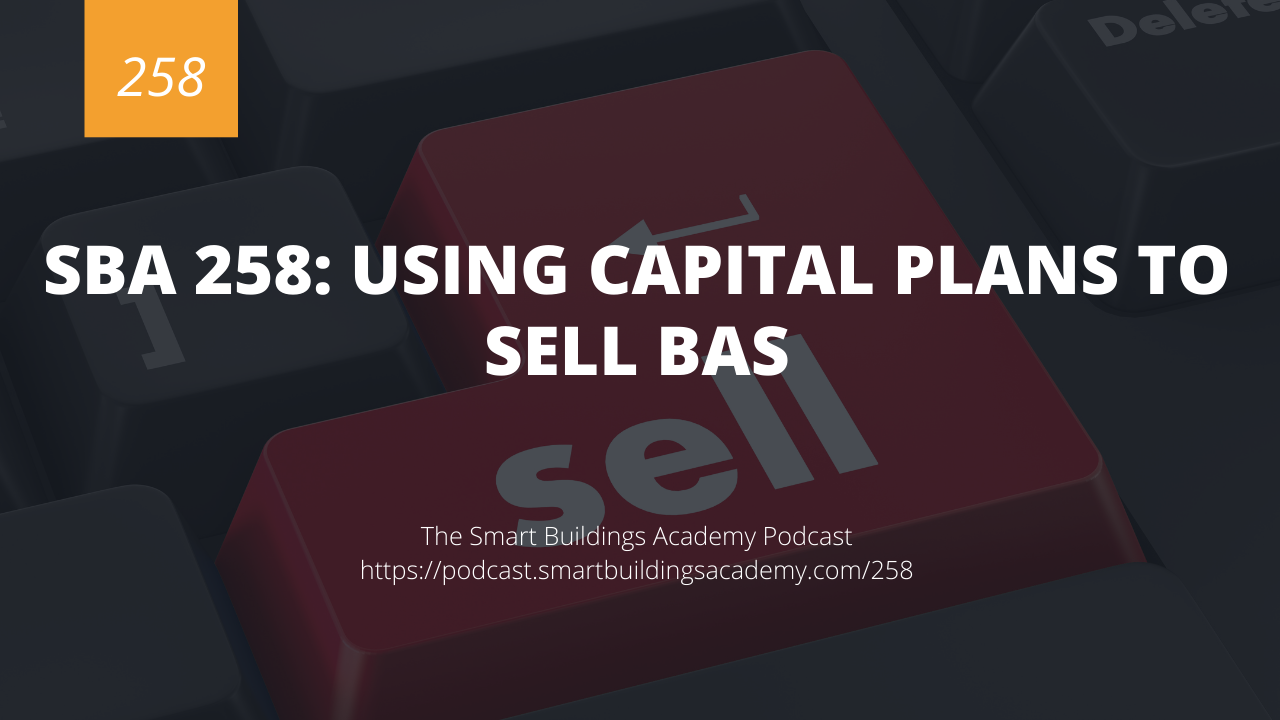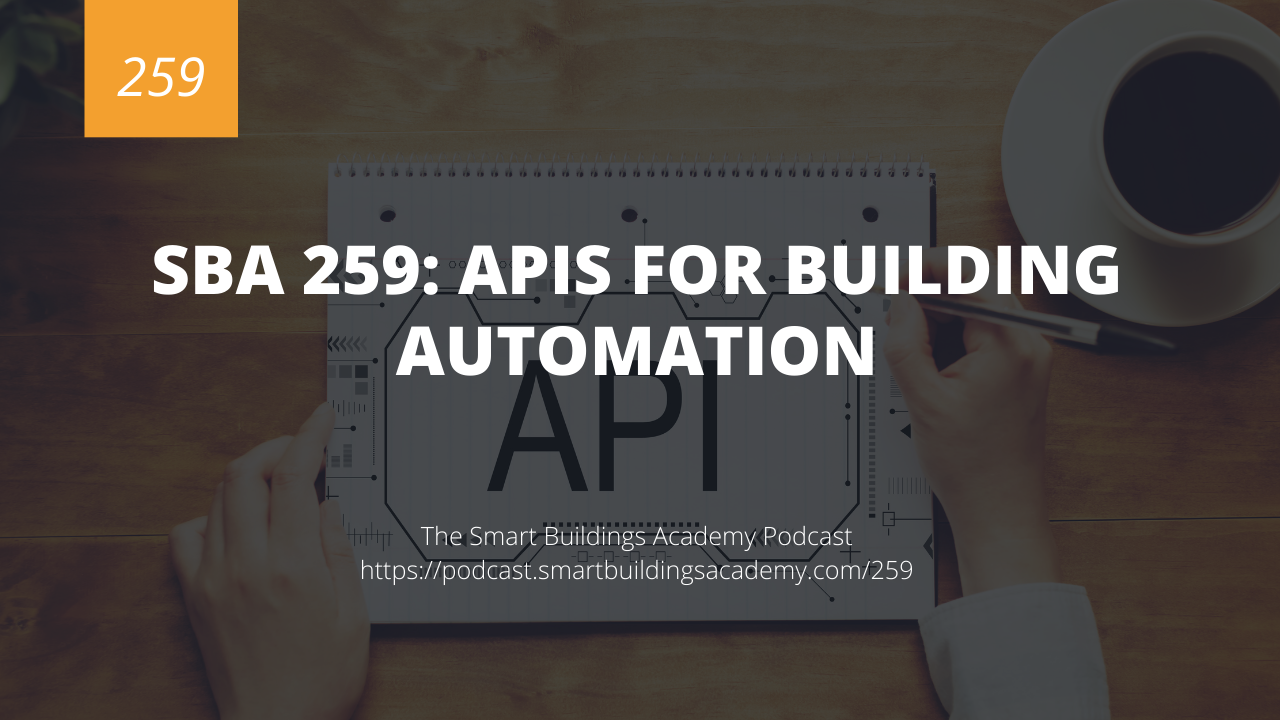In this episode of the Smart Buildings Academy Podcast, you will learn how to use information from capital plans to sell building automation systems.
Click here to download or listen to this episode now.
Resources mentioned in this episode


Transcript
Phil Zito 0:00
This is the smart buildings Academy podcast with Phil Zito Episode 258. Hey folks, Phil Zito here and welcome to Episode 258 of the smart buildings Academy podcast. And in this episode we are going to be discussing using capital plans to sell building automation systems. You know, this is something that it constantly surprises me that it is not discussed more often.
You know, it seems like when we bring on new sales people, all we tell them is Go in, go into dodge leads, go in, look at what bids are available, go and find out what projects are bidding and get your bids out or go and canvass the area of our service contracts and our existing installed base and try to get service contracts and try to get retrofits. But yet, there is a tool out there. I don't know if tool is the right word. But there is something out there called capital plans that if you understand how to actually go and read capital plans and how to take the information out of capital plans, you will really have an advantage from a sales perspective. So with that being said, everything can be found at podcast at smart buildings academy.com forward slash 258 once again, that is podcast at smart buildings Academy comm forward slash 258 I encourage you to go and check out all the additional resources if there are any. That will be there. I know for sure we will have a link to our sales bootcamp cohort to Cohort One was amazing. We've got people who are selling and closing business because of what they learned in Cohort One. And Cohort Two is now open for enrollment for our live sales bootcamp online course, that will be coming up in August. So if you sell building automation, and you'd like to sell more building automation, then you definitely need to check out this course. That being said, let's dive in to using capital plans to sell BS. Well, I'd be remiss if I assumed you knew what a capital plan was. So capital plan is the initiator for most capital projects. When we think of new construction and major retrofit, we're thinking of capital projects. Now, what's the difference between a capital and an operational project? A capital project is a project that uses allocated funds to develop a major, you know, large project, large initiative. So these are funds outside of the operational budget. And these funds can come from bonds, these funds can come from loans, these funds can come from set aside revenue, they can come from debt, there's a variety of different methods for getting the funds. But the fact of the matter remains that a capital plan exists over a long period of time, typically, we will plan out in five to 10 year ranges, what capital expansions or improvements are needed for a campus or for a building or for a enterprise. Now, when we talk about capital plans done right, and a good example of capital plans is the higher ed sector. If you really want to get kind of a grasp on capital plans, and how they can be done, really, in my opinion, efficiently, look at how schools go especially K through 12. Or sorry, not K through 12. Higher Ed. So we're talking colleges and universities, how they go and lay out their capital plans, they will go and have a capital plan process they will have a review process. They will have a process for prioritizing which projects take place they will have a process for evaluating those projects. They will have a process for estimating and selecting vendors of that process. Now, if you're listening and your ears are hearing me, all of that should be like triggering your sales Mojo. You should be sitting there going to myself yourself and being like, Oh my gosh, I could influence selection. I could influence prioritization. I could influence funding. And you can when you sell through capital plans, you can influence all of those you can influence scope, you can influence competitors, you can influence the specification. You often hear influence the specifier influence the contractor. Those are all well and good. But if you have a relationship with the customer, and you can influence the capital plan that is the highest level of influence. So how do we do that? Well, first off, we have to know if the customer even has capital plans and Capital Planning process.
Fortunately, via the internet, we can usually figure that out via Google search, we can go and look up capital plan, and then the name of the company, the name of the university, etc. And we'll usually get a result. And if we get that great, then we know what their capital plan is. And then we have to dig into the processes associated with capital plans, and the first process is going to be project selection. So what we have to figure out is how do they even come up with their projects? What pain points do they tie to their projects? How do they identify those pain points? How do they prioritize those pain points? What is both the qualitative and quantitative associations with these projects that prioritize them above others, because once you know those levers, you can go and flip those switches, right, you can say, Alright, with this customer, patient care is critical with this other customer, student success is critical. With this customer energy is critical, or reliabilities, critical, maybe it's a data center. Once you understand those, then you can position your projects and your additions to the capital plan under the guise of those KPIs and metrics, which increases the likelihood of you being able to go and get your project prioritized in the capital plan. Okay, so you've got a project, and it's getting prioritized in the capital plan. Now what? Well, now we want to go and take it a step further. Just because a project is getting put into the capital plan does not mean it's budgeted does not mean it's engineer does not mean it's scoped does not mean it's selected. So now we want to start to put some budget around it, we want to start helping to shape the budget and the funding mechanisms. Now, if you're part of a large, OEM, this is nice, because you oftentimes have access to financing and funding mechanisms that smaller organizations do not. But just because you may be part of a small organization does not mean you cannot influence funding, you can definitely go and research funding from utilities, rebates, etc. And you can bring that to the table as part of a funding package that can then help prioritize a capital plan. Like if you have a capital improvement for a building or set of buildings that involves putting vfds in all of these air handlers, and you've got funding from the local utility to do that, that is going to go and provide payback, right, that's going to offset capital costs. And that's going to help prioritize your project as far as compared to other projects. So you definitely want to look at that, right. So up to this point, we've identified their KPIs, we've got our project added to the list, we've started to find some funding mechanisms. Now we need to move into scoping. And we need to get ourselves selected as the vendor of choice. So now we can start to help write guide specs, we can help, right, owner project requirements or op ours. And we can help to facilitate the creation of these things and put what are called hooks into that, that bring us as the vendor of choice. Now, obviously, well, I'm not going to say obviously, I say obviously way too much. And maybe it's obvious to me, but that's only because of my experience. And there's plenty I don't know. So what I will say is one of the things that some folks will miss is you don't necessarily have to come in as a contractor. You can also come in as a consultant, you can come in as an executing consultant, whereas not only are you doing the consulting in the initial phase design, but you're doing the entire lifecycle, right, you're executing the capital project itself, and maybe even intermixing, some post project service for maintenance of the system. And I really like to do that in a capital project I like to go in if possible, not always possible. But if possible, I like to sell a lifecycle project, where I am helping to go and design the project, engineer the project, and then I'm going and executing project and then I'm supporting the project. And you may be saying to yourself by Phil, we have no engineers on staff. That's fine. There's so many engineers that you can contract as like 1099 contractors, have them work under you stamp the drawings, and then be able to go and execute. So you can do that. He may say, Phil, I'm only a service organization. How can I execute this? Well then retool your service folks to do some execution or hire some more folks maybe put them through our training so that you have trained techs that can actually install next few projects, you may say yourself, Phil, I have no service organization. Well, once again, expand your team's capabilities. Look at how can I grow my team? How can I expand my capabilities to execute service opportunities? So to recap, we have capital plans, we can research that through simple Google search. Once we understand that we understand our customers keep KPIs and key motivators. And we use that to position our projects favorably. We look at funding sources and ways of offsetting capital costs so that we can prioritize our project above others. And then we look at that lifecycle approach of being both the designer slash consultant executer and supporter of the project. If you take this approach, you will increase your pipeline, you will increase crease your close rate and you will start building a backlog of work for your company to execute. If you have any questions, do not hesitate to reach out. Thanks a ton. And I look forward to talking to you in the next podcast. Take care





